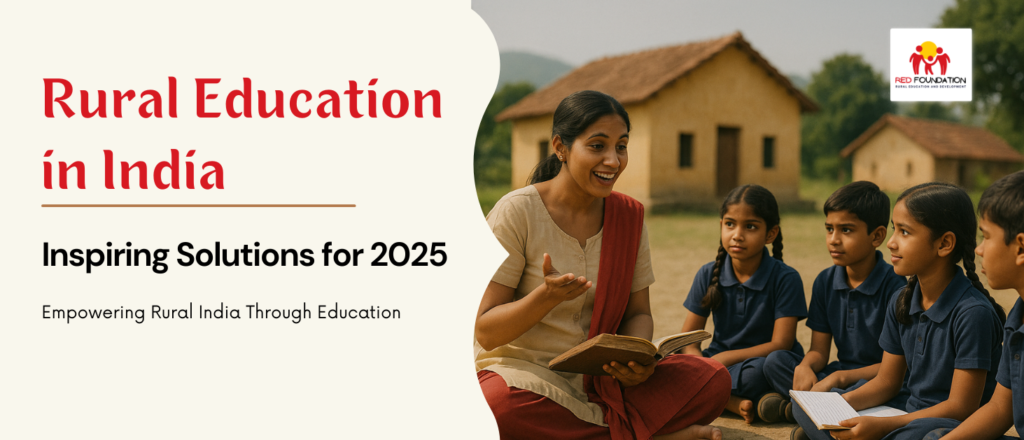Rural education in India faces several pressing challenges, yet it remains one of the most powerful tools for societal transformation and individual empowerment. Providing quality and accessible education to rural communities is not just a developmental priority—it’s a necessity for inclusive growth. In this article, we explore the key issues impacting rural education in India and offer inspiring solutions that promise a brighter future.
The Infrastructure Gap: A Barrier to Learning
One of the most fundamental challenges in rural education is the lack of basic infrastructure. According to UDISE+ data, only 56% of rural schools have functional toilets for girls, which leads many adolescent girls to drop out during critical school years. The absence of clean drinking water, proper classrooms, and reliable electricity significantly hampers learning outcomes and discourages regular attendance.
Schools with dilapidated facilities and unhygienic environments send a disheartening message to students and their families about the value placed on education. Bridging this infrastructure gap is essential to creating an environment conducive to learning.
Teacher Shortages: A Crisis in Rural Education
India’s rural schools suffer from a chronic shortage of qualified teachers. The teacher-student ratio in upper secondary education is projected to worsen from 35.98 in 2024 to 38.15 by 2028. In many schools, existing teachers are overwhelmed with administrative tasks, leaving little time for effective classroom engagement. Moreover, limited access to professional training and pedagogical support results in ineffective teaching methods and higher dropout rates.
Addressing this crisis requires strategic investments in teacher recruitment and ongoing training programs that empower educators and enhance classroom instruction.
Poverty and Patriarchy: The Socio-Economic Divide
Socio-economic inequality is another major roadblock. Many rural families prioritize survival over schooling, especially when it comes to educating girls. According to UNICEF, 34% of Indian girls are married before the age of 18, cutting short their educational journeys. Responsibilities like household chores, caregiving, and early marriages prevent many girls from attending school.
Targeted interventions that provide economic support and community awareness are essential to break this cycle and ensure that girls have equal opportunities to learn.
Quality vs. Access: The Dual Challenge
While enrollment rates have improved, the quality of education remains a concern. Many government schools still rely on outdated curricula and rote learning methods. When students fail to find relevance or engagement in their education, dropout rates climb, perpetuating poverty and illiteracy.
Improving education quality while expanding access must be a simultaneous effort. Modern teaching methodologies, activity-based learning, and student-centered classrooms are vital components of this transformation.
What Needs to Change? Practical Solutions for Rural Education
Solving the complex issues surrounding rural education requires a multi-dimensional strategy:
- Infrastructure Development: Government initiatives like Samagra Shiksha Abhiyan should focus on upgrading school infrastructure—functional toilets, clean drinking water, and safe classrooms.
- Teacher Empowerment: Recruiting qualified teachers and providing regular training will ensure better student outcomes and reduce dropout rates.
- Community Engagement: Grassroots campaigns promoting the importance of education—especially for girls—can shift mindsets and encourage higher attendance.
- Economic Support Systems: Scholarships, free school supplies, uniforms, and nutritious mid-day meals can ease financial burdens and motivate children to stay in school.
- Digital Learning Tools: E-learning platforms and smart classrooms can bridge the gap caused by teacher shortages and bring innovation to rural education.
Success Stories: What’s Working?
India has witnessed several promising initiatives that are transforming rural education. The Mid-Day Meal Scheme has significantly improved attendance and nutrition. Campaigns like Beti Bachao, Beti Padhao are changing mindsets and increasing female enrollment in schools.
Changing the Narrative: The Road Ahead
To truly uplift rural education in India, we must adopt a comprehensive, inclusive, and collaborative approach. From improving infrastructure to empowering teachers and engaging communities, the goal should be to build a system where every child, regardless of their background, has a fair chance to succeed.
Our Role at Red Foundation
At Red Foundation, we are deeply committed to advancing rural child education across India. By working directly with communities, supporting government efforts, and providing school supplies and learning resources, we aim to empower children through education. Our mission is to ensure that no child is left behind due to poverty or lack of access. We believe that education is the most powerful catalyst for change in rural India.
Conclusion
Rural education in India stands at a pivotal moment. With thoughtful planning, targeted investments, and community collaboration, we can overcome current challenges and unlock the true potential of rural youth. NGOs like Red Foundation, along with government and civic bodies, must continue to champion this cause and work together to bring lasting change.

